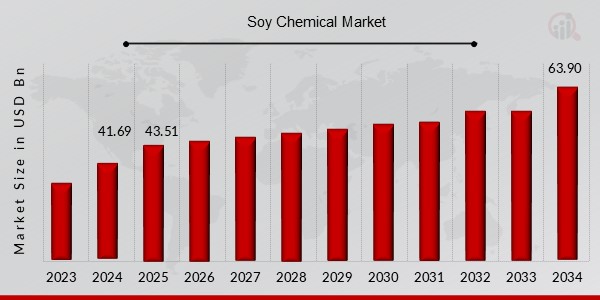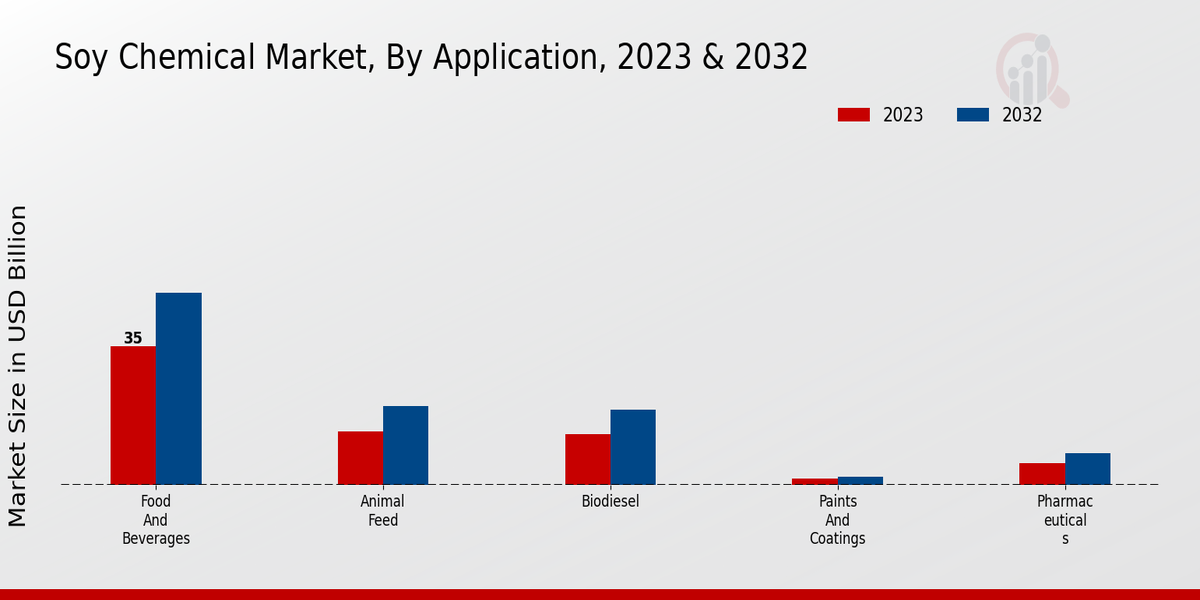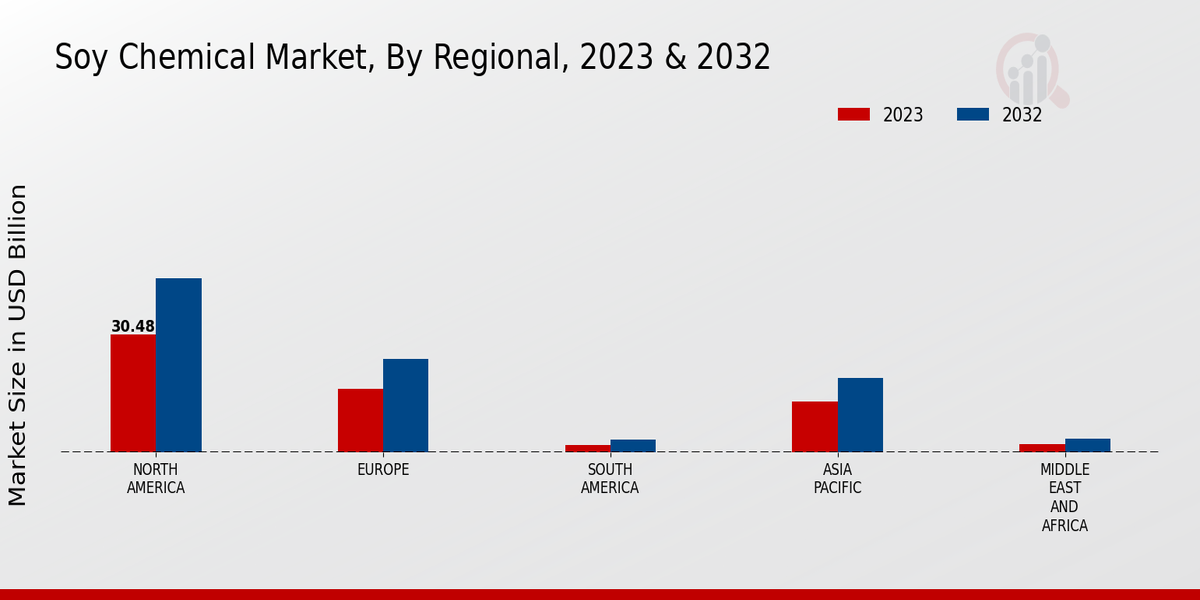Global Soy Chemical Market Overview
The Soy Chemical Market Size was estimated at 41.69 (USD Billion) in 2024. Soy Chemical Industry is expected to grow from 43.51 (USD Billion) in 2025 to 63.90 (USD Billion) by 2034, at a CAGR (growth rate) is expected to be around 4.36% during the forecast period (2025 - 2034)
Key Soy Chemical Market Trends Highlighted
The soy chemical market is on an upswing owing to rising demand from various end-use sectors, especially the food and beverage industry. The increasing adoption of plant-based alternatives in the food industry, particularly driven by veganism and flexitarian diets, has stimulated the demand for soy proteins, which are isolated or concentrated from soybeans for use as meat extenders, dairy substitutes, and other food products. Additionally, the growing consumer awareness regarding the health benefits associated with soy products, such as improved cardiovascular health and reduced cholesterol levels, is further fueling the market growth. Moreover, the expanding applications of soy chemicals in pharmaceuticals, cosmetics, and personal care products are creating new opportunities for market expansion.

Source: Primary Research, Secondary Research, MRFR Database and Analyst Review
Soy Chemical Market Drivers
Rising Demand for Soy-Based Products
The increasing consumption of soy-based products, such as tofu, tempeh, and soy milk, is a key driver of the Soy Chemical Market. Soy-based products are becoming increasingly popular due to their nutritional value, affordability, and versatility. They are a good source of protein, fiber, and other essential nutrients, making them a healthy and sustainable alternative to animal-based products. The growing demand for soy-based products is expected to continue in the coming years, driven by increasing health consciousness and the adoption of plant-based diets.
Expansion of the Biodiesel Industry
The growing use of biodiesel as a renewable and sustainable alternative to fossil fuels is another major driver of the Soy Chemical Market. Soy-based biodiesel is produced from soybean oil, which is a byproduct of the soy processing industry. The increasing demand for biodiesel is driven by government regulations and incentives promoting the use of renewable energy sources. The expansion of the biodiesel industry is expected to continue in the coming years, supported by government policies and the growing demand for sustainable energy sources.
Technological Advancements in Soy Processing
The advancement of technologies in soy processing is also contributing to the growth of the Soy Chemical Market. These advancements have led to increased efficiency and cost-effectiveness in the production of soy-based products. For example, the development of new enzymes and microorganisms has improved the extraction and utilization of soy proteins and oils. The continuous innovation in soy processing technologies is expected to further drive the growth of the soy chemical market in the coming years.
Soy Chemical Market Segment Insights
Soy Chemical Market Application Insights
The Soy Chemical Market segmentation by Application comprises Food and Beverages, Animal Feed, Biodiesel, Paints and Coatings, and Pharmaceuticals. The Food and Beverages segment held the largest market share in 2023, accounting for over 35% of the Soy Chemical Market revenue. The demand for soy-based ingredients in food and beverage applications is driven by their nutritional value, versatility, and cost-effectiveness. Soy proteins are used as meat extenders, emulsifiers, and texture modifiers in various food products. The Animal Feed segment is another significant application area for soy chemicals.Soy meal is a high-protein ingredient used in animal feed formulations, particularly for poultry and swine. The growing demand for animal protein is expected to drive the growth of the Animal Feed segment in the coming years. Biodiesel is a renewable fuel produced from vegetable oils, including soybean oil. Soy-based biodiesel is gaining popularity due to its environmental benefits and government incentives. The Biodiesel segment is expected to witness steady growth in the coming years, driven by increasing demand for sustainable energy sources.Paints and Coatings are another application area for soy chemicals. Soy-based resins are used in the production of eco-friendly paints and coatings. These resins offer excellent durability, adhesion, and water resistance. The Paints and Coatings segment is expected to grow at a moderate pace in the coming years. Pharmaceuticals is a niche application area for soy chemicals. Soy-based ingredients are used in the production of certain pharmaceuticals, such as isoflavones, which have antioxidant and estrogenic properties. The Pharmaceuticals segment is expected to experience modest growth in the coming years.

Source: Primary Research, Secondary Research, MRFR Database and Analyst Review
Soy Chemical Market Product Type Insights
The Soy Chemical Market is segmented by product type into soybean meal, soybean oil, soy protein concentrate, soy protein isolate, and lecithin. Among these, soybean meal holds the largest market share due to its wide application in animal feed. The demand for soybean meal is expected to continue to grow in the coming years, driven by the increasing demand for meat and poultry products. Soybean oil is another major product type in the soy chemical market, with applications in food, industrial, and biofuel industries. The growing demand for healthy and sustainable food products is expected to drive the growth of the soybean oil segment.Soy protein concentrate and soy protein isolate are used in a variety of food and beverage products, including meat alternatives, protein bars, and nutritional supplements. The increasing demand for plant-based proteins is expected to drive the growth of these segments. Lecithin is a versatile emulsifier and stabilizer used in a wide range of food and industrial applications. The demand for lecithin is expected to grow in the coming years, driven by the increasing demand for processed foods and beverages.
Soy Chemical Market Extraction Method Insights
The Soy Chemical Market segmentation by Extraction Method includes Solvent Extraction, Mechanical Pressing, and Extrusion. Solvent Extraction dominated the market in 2023, accounting for over 65% of the Soy Chemical Market revenue. This is attributed to its high efficiency and cost-effectiveness. Mechanical Pressing is expected to grow at a CAGR of 4.5% during the forecast period, owing to its ability to retain the nutritional value of soy products. Extrusion is projected to witness a CAGR of 4.2%, driven by its use in the production of soy protein concentrates and isolates.
Soy Chemical Market Soybean Source Insights
The Soybean Source segment of the Soy Chemical Market is bifurcated into Non-GMO Soybeans and Genetically Modified Soybeans. Non-GMO Soybeans accounted for a larger revenue share in 2023 and are projected to maintain their dominance throughout the forecast period. The growing consumer preference for natural and organic products is driving the demand for Non-GMO Soybeans. Additionally, the increasing awareness about the potential health risks associated with Genetically Modified Soybeans is further fueling the growth of the Non-GMO Soybeans market.However, Genetically Modified Soybeans are gaining popularity due to their higher yield and resistance to pests and diseases. The Soy Chemical Market revenue for Non-GMO Soybeans is expected to reach USD 23.14 Billion by 2026, growing at a CAGR of 4.5%, while the revenue for Genetically Modified Soybeans is projected to reach USD 15.03 Billion by 2026, growing at a CAGR of 4.2%.
Soy Chemical Market Regional Insights
The regional segmentation of the Soy Chemical Market offers valuable insights into the market's geographical distribution and growth dynamics. In 2023, North America dominated the market, accounting for a significant share of the Soy Chemical Market revenue. Europe and APAC followed as prominent regional markets, showcasing steady growth rates. South America and MEA are emerging markets with potential for future growth. The market in North America benefits from advanced agricultural practices and a well-established food industry. Europe has a strong demand for soy-based products, particularly in the food and beverage sector.APAC, with its large population and rising disposable income, presents significant opportunities for the soy chemical industry. South America is witnessing increased soy production and exports, while MEA is expected to experience a surge in demand for soy-based products due to its growing population and urbanization.

Source: Primary Research, Secondary Research, MRFR Database and Analyst Review
Soy Chemical Market Key Players And Competitive Insights
Major players in the Soy Chemical Market industry are constantly engaged in research and development to enhance their product offerings and gain a competitive edge. They are also focusing on strategic partnerships, acquisitions, and mergers to expand their global reach and strengthen their market position. Leading Soy Chemical Market players are investing heavily in innovation to develop new products and applications that meet the evolving demands of end-users. The Soy Chemical Market development is driven by increasing demand from various industries, such as food and beverage, pharmaceuticals, and cosmetics. The growing awareness of the health benefits associated with soy-based products is further fueling market growth.Archer Daniels Midland Company (ADM) is a global leader in the Soy Chemical Market, with a wide range of soy-based products for various industries. The company has a strong presence in North America, South America, Europe, and Asia-Pacific. ADM focuses on providing innovative and sustainable solutions to its customers, and its research and development efforts are focused on developing new products and applications for soy ingredients. The company's commitment to sustainability has earned it recognition as a leader in the industry.Bunge Limited is another major player in the Soy Chemical Market, with a global presence and a diversified portfolio of soy-based products. The company has a strong focus on innovation and sustainability, and it invests heavily in research and development to improve its product offerings. Bunge has a strong presence in North America, South America, Europe, and Asia-Pacific, and it is committed to providing high-quality products and services to its customers. The company's commitment to sustainability has earned it recognition as a leader in the industry.
Key Companies in the Soy Chemical Market Include
- LDC S.A.
- The Andersons, Inc.
- Wilmar International Ltd.
- Cofco International Ltd.
- Sumitomo Corporation
- Mitsui , Ltd.
- CHS Inc.
- Marubeni Corporation
- Louis Dreyfus Company B.V.
- Archer Daniels Midland Company
- Bunge Limited
- GrainCorp Limited
- Cargill, Incorporated
- Olam International Ltd.
Soy Chemical Market Industry Developments
The Soy Chemical Market is projected to grow from USD 38.28 billion in 2023 to USD 56.17 billion by 2032, at a CAGR of 4.36%. Increasing demand for soy-based products in the food and beverage, animal feed, and biofuel industries is driving the market growth.Recent developments include the growing adoption of sustainable practices in soy production, such as non-GMO and organic farming. Technological advancements in soy processing, such as the development of high-protein soy ingredients, are also contributing to market growth. Key players in the market include Archer Daniels Midland Company, Bunge Limited, and Cargill, Incorporated.
Soy Chemical Market Segmentation Insights
- Soy Chemical Market Application Outlook
- Food and Beverages
- Animal Feed
- Biodiesel
- Paints and Coatings
- Pharmaceuticals
- Soy Chemical Market Product Type Outlook
- Soybean Meal
- Soybean Oil
- Soy Protein Concentrate
- Soy Protein Isolate
- Lecithin
- Soy Chemical Market Extraction Method Outlook
- Solvent Extraction
- Mechanical Pressing
- Extrusion
- Soy Chemical Market Soybean Source Outlook
- Non-GMO Soybeans
- Genetically Modified Soybeans
| Report Attribute/Metric |
Details |
| Active
Market Size 2024
|
41.69 (USD Billion)
|
|
Market Size 2025
|
43.51 (USD Billion)
|
|
Market Size 2034
|
63.90 (USD Billion)
|
|
Compound Annual Growth Rate (CAGR)
|
4.36% (2025 - 2034)
|
|
Report Coverage
|
Revenue Forecast, Competitive Landscape, Growth Factors, and Trends
|
|
Base Year
|
2024
|
|
Market Forecast Period
|
2025 - 2034
|
|
Historical Data
|
2020 - 2024
|
| Market Forecast Units |
USD Billion |
| Key Companies Profiled |
LDC S.A., The Andersons, Inc., Wilmar International Ltd., Cofco International Ltd., Sumitomo Corporation, Mitsui Co., Ltd., CHS Inc., Marubeni Corporation, Louis Dreyfus Company B.V., Archer Daniels Midland Company, Bunge Limited, GrainCorp Limited, Cargill, Incorporated, Olam International Ltd. |
| Segments Covered |
Application, Product Type, Extraction Method, Soybean Source, Regional |
| Key Market Opportunities |
Increased demand for plant-based proteins Growing use in food additives Expanding applications in bioplastics Rising demand in animal feed New product innovations |
| Key Market Dynamics |
Rising demand for sustainable products Increasing health consciousness Technological advancements Growing applications in the animal feed industry Fluctuating prices of raw materials. |
| Countries Covered |
North America, Europe, APAC, South America, MEA |
Frequently Asked Questions (FAQ) :
The soy chemical market is anticipated to reach USD 41.69 billion by 2034, reflecting a CAGR of 4.36% from 2024.
The Asia-Pacific region is projected to witness significant growth due to rising demand for soy-based products and increasing population.
Increasing demand for sustainable and biodegradable materials, growing consumption of soy-based food products, and government initiatives promoting bio-based chemicals are key growth drivers.
Major applications include adhesives, coatings, inks, plastics, and pharmaceuticals, among others.
Archer Daniels Midland Company, Cargill Incorporated, DuPont, and BASF SE are prominent players in the soy chemical industry.
Fluctuating raw material prices, competition from synthetic chemicals, and environmental concerns pose challenges to the soy chemical market.
Investing in research and development, expanding into new applications, and exploring sustainable production practices can create growth opportunities.
Growing demand for bio-based and eco-friendly products, technological advancements, and increasing awareness of sustainability are shaping the future of the industry.
Government regulations aimed at promoting sustainability and reducing environmental impact will influence the market.
Rising environmental consciousness, increasing consumer preference for natural and biodegradable products, and government support for sustainable initiatives are driving demand.
















